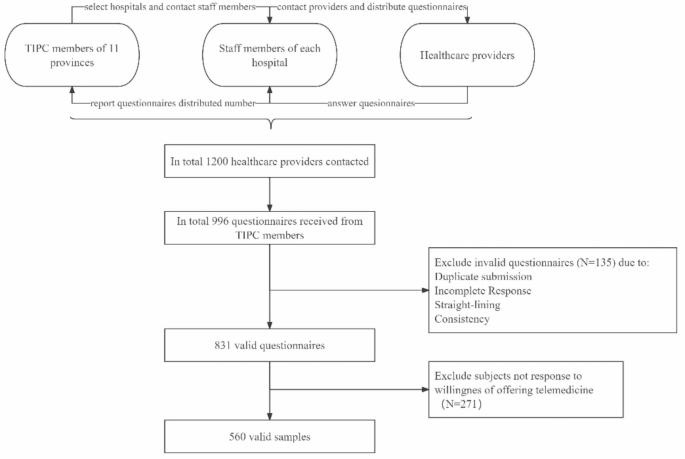Monaghesh, E. & Hajizadeh, A. The role of telehealth during COVID-19 outbreak: a systematic review based on current evidence. BMC Public. Health. 20, 1193. https://doi.org/10.1186/s12889-020-09301-4 (2020).
Google Scholar
Hong, Z. et al. Telemedicine during the COVID-19 pandemic: experiences from Western China. J. Med. Internet Res. 22, e19577. https://doi.org/10.2196/19577 (2020).
Google Scholar
Barney, A., Buckelew, S., Mesheriakova, V. & Raymond-Flesch, M. The COVID-19 pandemic and rapid implementation of adolescent and young adult telemedicine: challenges and opportunities for innovation. J. Adolesc. Health. 67, 164–171. https://doi.org/10.1016/j.jadohealth.2020.05.006 (2020).
Google Scholar
Smolić, S., Blaževski, N. & Fabijančić, M. Remote healthcare during the COVID-19 pandemic: findings for older adults in 27 European countries and Israel. Front. Public. Health. 10, 921379. https://doi.org/10.3389/fpubh.2022.921379 (2022).
Google Scholar
Serper, M. et al. Positive early patient and clinician experience with telemedicine in an academic gastroenterology practice during the COVID-19 pandemic. Gastroenterology 159, 1589–1591. https://doi.org/10.1053/j.gastro.2020.06.034 (2020).
Google Scholar
Paffenholz, P. et al. Impact of the COVID-19 pandemic on urologists in Germany. Eur. Urol. Focus. 6, 1111–1119. https://doi.org/10.1016/j.euf.2020.06.001 (2020).
Google Scholar
The State Council. The People’s Republic of China. Opinions on Promoting Telemedicine Services in Medical Institutions. https://www.gov.cn/gongbao/content/2014/content_2792664.htm (2014).
Zhang, W., He, D., Wang, G., Zhu, C. & Evans, R. Analyzing National telemedicine policies in China from the perspective of policy instrument (1997–2020). Int. J. Med. Inf. 166, 104854. https://doi.org/10.1016/j.ijmedinf.2022.104854 (2022).
Google Scholar
Ye, J., He, L. & Beestrum, M. Implications for implementation and adoption of telehealth in developing countries: a systematic review of China’s practices and experiences. NPJ Digit. Med. 6, 174. https://doi.org/10.1038/s41746-023-00908-6 (2023).
Google Scholar
Fu, H., Cheng, T. C., Zhan, J., Xu, D. & Yip, W. Dynamic effects of the COVID-19 pandemic on the demand for telemedicine services: evidence from China. J. Econ. Behav. Organ. 220, 531–557. https://doi.org/10.1016/j.jebo.2024.02.015 (2024).
Google Scholar
Gao, J. et al. Telemedicine is becoming an increasingly popular way to resolve the unequal distribution of healthcare resources: evidence from China. Front. Public. Health. 10, 916303. https://doi.org/10.3389/fpubh.2022.916303 (2022).
Google Scholar
Cheng, T. C. & Yip, W. Progress, policies and prospects for internet telemedicine in China. https://www.hsph.harvard.edu/takemi/wp-content/uploads/sites/114/2023/10/TakemiSymposium_Cheng.pdf (2023).
The State Council. The People’s Republic of China. Telemedicine services cover all Chinese cities. https://english.www.gov.cn/news/202307/30/content_WS64c62185c6d0868f4e8de35b.html (2023).
Abdelghany, I. K., AlMatar, R., Al-Haqan, A., Abdullah, I. & Waheedi, S. Exploring healthcare providers’ perspectives on virtual care delivery: insights into telemedicine services. BMC Health Serv. Res. 24, 1. https://doi.org/10.1186/s12913-023-10244-w (2024).
Google Scholar
Ma, Q. et al. Usage and perceptions of telemedicine among health care professionals in China. Int. J. Med. Inf. 166, 104856. https://doi.org/10.1016/j.ijmedinf.2022.104856 (2022).
Google Scholar
Houlding, E. et al. Barriers to use of remote monitoring technologies used to support patients with COVID-19: rapid review. JMIR Mhealth Uhealth. 9, e24743. https://doi.org/10.2196/24743 (2021).
Google Scholar
Kruse, C. & Heinemann, K. Facilitators and barriers to the adoption of telemedicine during the first year of COVID-19: systematic review. J. Med. Internet Res. 24, e31752. https://doi.org/10.2196/31752 (2022).
Google Scholar
Assaye, B. T. et al. Perception towards the implementation of telemedicine during COVID-19 pandemic: a cross-sectional study. BMC Health Serv. Res. 23, 967. https://doi.org/10.1186/s12913-023-09927-1 (2023).
Google Scholar
Reingold, S. M. et al. COVID-19 era effect on pandemic and Post-pandemic pediatric telemedicine use: A survey of the European academy of pediatrics research in ambulatory settings network. Front. Pediatr. 9, 713930. https://doi.org/10.3389/fped.2021.713930 (2021).
Google Scholar
Mohammadi, E. et al. Post-pandemic paradigm shift toward telemedicine and tele-education; an updated survey of the impact of Covid-19 pandemic on neurosurgery residents in united States. World Neurosurg. X. 23, 100326. https://doi.org/10.1016/j.wnsx.2024.100326 (2024).
Google Scholar
Jung, S. E., Kwon, Y., Kwon, S., Kim, Y. & Park, H. Satisfaction survey of medical staff for telemedicine after the COVID-19 pandemic: A comparison between the COVID-Pandemic and Post-COVID pandemic periods. Telemed J. E Health. 31, 50–58. https://doi.org/10.1089/tmj.2024.0142 (2025).
Google Scholar
Chandrasekaran, R. Telemedicine in the Post-Pandemic period: Understanding patterns of use and the influence of socioeconomic demographics, health status, and social determinants. Telemed J. E Health. 30, 480–489. https://doi.org/10.1089/tmj.2023.0277 (2024).
Google Scholar
Moulaei, K., Sheikhtaheri, A., Fatehi, F., Shanbehzadeh, M. & Bahaadinbeigy, K. Patients’ perspectives and preferences toward telemedicine versus in-person visits: a mixed-methods study on 1226 patients. BMC Med. Inf. Decis. Mak. 23, 261. https://doi.org/10.1186/s12911-023-02348-4 (2023).
Google Scholar
Splinter, M. J. et al. Patient perspectives on telemedicine during the COVID-19 pandemic: a mixed-methods community-based study. BMC Health Serv. Res. 23, 803. https://doi.org/10.1186/s12913-023-09794-w (2023).
Google Scholar
Kruse, C. S. et al. Telehealth and patient satisfaction: a systematic review and narrative analysis. BMJ Open. 7, e016242. https://doi.org/10.1136/bmjopen-2017-016242 (2017).
Google Scholar
Davis, F. D. Perceived usefulness, perceived ease of use, and user acceptance of information technology. MIS QUART. 13, 319–340. https://doi.org/10.2307/249008 (1989).
Google Scholar
Schifter, D. E. & Ajzen, I. Intention, perceived control, and weight loss: an application of the theory of planned behavior. J. Pers. Soc. Psychol. 49, 843–851. https://doi.org/10.1037/0022-3514.49.3.843 (1985).
Google Scholar
The State Council. The People’s Republic of China. 2023 Statistical Bulletin on the Development of Health and Wellness in China. https://www.gov.cn/lianbo/bumen/202408/content_6971241.htm (2023).
Kish, L. Sampling organizations and groups of unequal sizes. Am. Sociol. Rev. 30, 564–572 (1965).
Google Scholar
Hah, H., Goldin, D. & Ha, S. The association between willingness of frontline care providers’ to adaptively use telehealth technology and virtual service performance in provider-to-provider communication: quantitative study. J. Med. Internet Res. 21, e15087. https://doi.org/10.2196/15087 (2019).
Google Scholar
Albarrak, A. I. et al. Assessment of physician’s knowledge, perception and willingness of telemedicine in Riyadh region, Saudi Arabia. J. Infect. Public. Health. 14, 97–102. https://doi.org/10.1016/j.jiph.2019.04.006 (2021).
Google Scholar
Thapa, S., Nielsen, J. B., Aldahmash, A. M., Qadri, F. R. & Leppin, A. Willingness to use digital health tools in patient care among health care professionals and students at a university hospital in Saudi Arabia: quantitative Cross-sectional survey. JMIR Med. Educ. 7, e18590. https://doi.org/10.2196/18590 (2021).
Google Scholar
Muehlensiepen, F., Petit, P., Knitza, J., Welcker, M. & Vuillerme, N. Factors associated with telemedicine use among German general practitioners and rheumatologists: secondary analysis of data from a nationwide survey. J. Med. Internet Res. 24, e40304. https://doi.org/10.2196/40304 (2022).
Google Scholar
Chereka, A. A. et al. Attitudes towards telemedicine services and associated factors among health professionals in Ethiopia: a systematic review and meta-analysis. BMC Health Serv. Res. 24, 1505. https://doi.org/10.1186/s12913-024-11979-w (2024).
Google Scholar
Ahmed, M. H. et al. Willingness to use telemedicine during COVID-19 among health professionals in a low income country. Inf. Med. Unlocked. 27, 100783. https://doi.org/10.1016/j.imu.2021.100783 (2021).
Google Scholar
Sutherland, B. L., Pecanac, K., LaBorde, T. M., Bartels, C. M. & Brennan, M. B. Good working relationships: how healthcare system proximity influences trust between healthcare workers. J. Interprof Care. 36, 331–339. https://doi.org/10.1080/13561820.2021.1920897 (2022).
Google Scholar
Ftouni, R., AlJardali, B., Hamdanieh, M., Ftouni, L. & Salem, N. Challenges of telemedicine during the COVID-19 pandemic: a systematic review. BMC Med. Inf. Decis. Mak. 22, 207. https://doi.org/10.1186/s12911-022-01952-0 (2022).
Google Scholar
Almathami, H. K. Y., Win, K. T. & Vlahu-Gjorgievska, E. Barriers and facilitators that influence telemedicine-based, real-time, online consultation at patients’ homes: systematic literature review. J. Med. Internet Res. 22, e16407. https://doi.org/10.2196/16407 (2020).
Google Scholar
Antonacci, G. et al. Healthcare professional and manager perceptions on drivers, benefits, and challenges of telemedicine: results from a cross-sectional survey in the Italian NHS. BMC Health Serv. Res. 23, 1115. https://doi.org/10.1186/s12913-023-10100-x (2023).
Google Scholar
Mareš, J. Resistance of health personnel to changes in healthcare. Kontakt 20, e262–e272. https://doi.org/10.1016/j.kontakt.2018.04.002 (2018).
Google Scholar
Escobar-Rodríguez, T. & Romero-Alonso, M. The acceptance of information technology innovations in hospitals: differences between early and late adopters. Behav. Inf. Technol. 33, 1231–1243. https://doi.org/10.1080/0144929X.2013.810779 (2013).
Google Scholar
Kuek, A. & Hakkennes, S. Healthcare staff digital literacy levels and their attitudes towards information systems. Health Inf. J. 26, 592–612. https://doi.org/10.1177/1460458219839613 (2020).
Google Scholar
Scott Kruse, C. et al. Evaluating barriers to adopting telemedicine worldwide: A systematic review. J. Telemed Telecare. 24, 4–12. https://doi.org/10.1177/1357633X16674087 (2018).
Google Scholar
Breton, M. et al. Telehealth challenges during COVID-19 as reported by primary healthcare physicians in Quebec and Massachusetts. BMC Fam Pract. 22, 192. https://doi.org/10.1186/s12875-021-01543-4 (2021).
Google Scholar
Domingos, C., Costa, P., Santos, N. C. & Pêgo, J. M. Usability, acceptability, and satisfaction of a wearable activity tracker in older adults: observational study in a real-life context in Northern Portugal. J. Med. Internet Res. 24, e26652. https://doi.org/10.2196/26652 (2022).
Google Scholar
Sora, B., Nieto, R., Del Campo, M., Armayones, M. & A. & Acceptance and use of telepsychology from the clients’ perspective: questionnaire study to document perceived advantages and barriers. JMIR Ment Health. 8, e22199. https://doi.org/10.2196/22199 (2021).
Google Scholar
Lee, S. J., Choi, M. J., Rho, M. J., Kim, D. J. & Choi, I. Y. Factors affecting user acceptance in overuse of smartphones in mobile health services: an empirical study testing a modified integrated model in South Korea. Front. Psychiatry. 9, 658. https://doi.org/10.3389/fpsyt.2018.00658 (2018).
Google Scholar
Gagnon, M. et al. Electronic health record acceptance by physicians: testing an integrated theoretical model. J. Biomed. Inf. 48, 17–27. https://doi.org/10.1016/j.jbi.2013.10.010 (2014).
Google Scholar
Harst, L., Lantzsch, H. & Scheibe, M. Theories predicting end-user acceptance of telemedicine use: systematic review. J. Med. Internet Res. 21, e13117. https://doi.org/10.2196/13117 (2019).
Google Scholar
Shen, Y. T., Chen, L., Yue, W. W. & Xu, H. X. Digital technology-based telemedicine for the COVID-19 pandemic. Front. Med. 8, 646506. https://doi.org/10.3389/fmed.2021.646506 (2021).
Google Scholar
Odendaal, W. A. et al. Health workers’ perceptions and experiences of using mHealth technologies to deliver primary healthcare services: a qualitative evidence synthesis. Cochrane Database Syst. Rev. 3, CD011942. https://doi.org/10.1002/14651858.CD011942.pub2 (2020).
Google Scholar
Alqurashi, H., Mohammed, R., AlGhanmi, A. S. & Alanazi, F. The perception of health care practitioners regarding telemedicine during COVID-19 in Saudi Arabia: mixed methods study. JMIR Form. Res. 7, e47065. https://doi.org/10.2196/47065 (2023).
Google Scholar
Seuren, L. M., Ilomäki, S., Dalmaijer, E., Shaw, S. E. & Stommel, W. J. P. Communication in telehealth: a state-of-the-art literature review of conversation-analytic research. Res. Lang. Soc. Interact. 57, 73–90. https://doi.org/10.1080/08351813.2024.2305045 (2024).
Google Scholar
Ahmed, A. et al. A systematic review of publications on perceptions and management of chronic medical conditions using telemedicine remote consultations by primary healthcare professionals April 2020 to December 2021 during the COVID-19 pandemic. Med. Sci. Monit. 30, e943383. https://doi.org/10.12659/MSM.943383 (2024).
Google Scholar
Alashek, W. A. & Ali, S. A. Satisfaction with telemedicine use during COVID-19 pandemic in the UK: a systematic review. Libyan J. Med. 19, 2301829. https://doi.org/10.1080/19932820.2024.2301829 (2024).
Google Scholar
Nguyen, M., Waller, M., Pandya, A. & Portnoy, J. A review of patient and provider satisfaction with telemedicine. Curr. Allergy Asthma Rep. 20, 72. https://doi.org/10.1007/s11882-020-00969-7 (2020).
Google Scholar
Shi, J. et al. Implementation, service effectiveness and satisfaction with teleconsultation services in China during the COVID-19 pandemic: from the perspective of primary health care professionals. Int. J. Med. Inf. 178, 105202. https://doi.org/10.1016/j.ijmedinf.2023.105202 (2023).
Google Scholar

